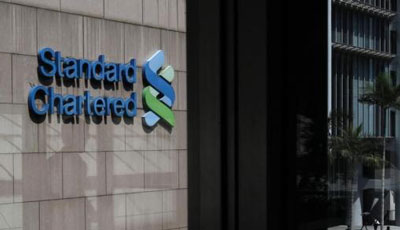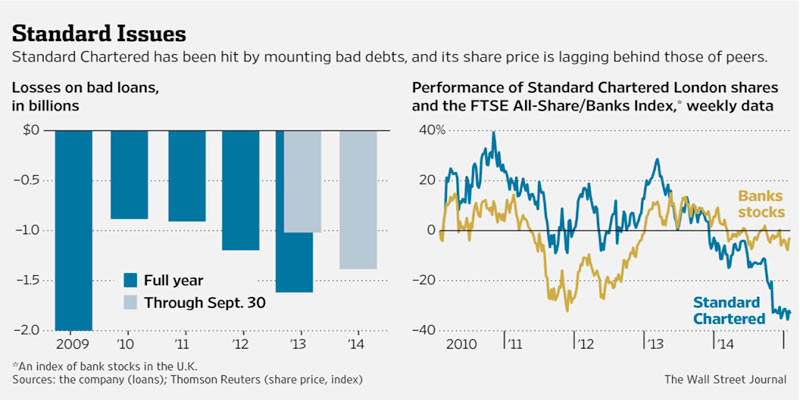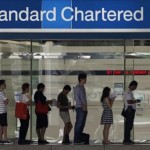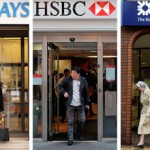Standard Chartered CEO Is Under Pressure From Shareholders, Regulators, Staff

Bank’s Top Shareholders Privately Push for New Leadership Amid Investor, Regulatory Anxiety
Hundreds of Standard Chartered PLC’s most senior executives gathered earlier this month on Singapore’s Sentosa island to address the global bank’s dimming fortunes. From a lectern at a colonial-style resort, Chief Executive Peter Sands warned that management has just a few months to turn around the bank or risk losing the support of the board of directors, according to attendees.
Mr. Sands, credited for years with leading perhaps the world’s most successful bank, now is in danger of becoming the latest big-bank CEO to lose his job following a series of high-profile stumbles.
Standard Chartered’s two largest shareholders, which collectively control 28% of the bank’s stock, are privately pushing for new leadership, say people familiar with the matter. Customers and regulators recently have told Standard Chartered executives and board members that they are increasingly anxious about the bank’s problems, people familiar with those discussions say.
Compounding the problem, some senior executives are privately blunt about their desire for Mr. Sands to be pushed out by the board, leaving him with diminished support within the organization. Standard Chartered recently has put out feelers to bankers at Citigroup Inc. and HSBC Holdings PLC about their interest in taking over the CEO job, say people familiar with the matter.
Behind the frustration: The bank’s share price is down by half since early 2013, far worse than rivals’ stock performance. Profits are down by about a fifth.
A flurry of analyst research this month has questioned the bank’s strategy and financial strength, with some calling for a management change. “You need a fresh set of eyes to deal with a different world,” said James Chappell, an analyst at Berenberg.
Standard Chartered says the bank’s board supports Mr. Sands’s strategy of exiting from unprofitable businesses, plowing money into promising areas and cutting hundreds of millions of dollars of costs. Despite the bank’s recent problems, it remains profitable, generating $4.8 billion in pretax profit in the first nine months of last year, and its capital levels are above regulatory minimums.
Mr. Sands “is doing a superb job and is making significant progress in repositioning the bank for long-term growth,” Chairman John Peace said in a statement. “He has my full support and that of the board.”
Some executives shrug off the notion of an internal revolt. “You’re always going to get some naysayers,” one said.
While not a household name in the U.S., Standard Chartered boasts one of the world’s largest banking networks, stretching across much of Asia and Africa. That emerging-markets footprint fueled a decade of heady growth. And its ability to sail through the financial crisis, thanks in part to its relatively small investment-banking business, made it the envy of the industry.
While many of its competitors responded to the crisis by scaling back their global ambitions, Mr. Sands and his team continued pushing for swift expansion. Bankers at Standard Chartered privately say they responded in some cases by relaxing lending standards.
Mr. Sands, a spiky-white-haired 53-year-old, grew up in Asia. After attending Oxford and Harvard universities, he worked for the U.K.’s Foreign & Commonwealth Office. Then he joined McKinsey & Co. as a consultant. He became Standard Chartered’s CEO in 2006.
The bank’s success made Mr. Sands an industry celebrity. He was feted by government leaders and central bankers. Euromoney magazine honored him as Banker of the Year in July 2012, saying he “must rank as one of the best bankers of his generation.”
But Standard Chartered’s aggressive push into risky markets backfired soon after. A turning point for its glowing reputation came later in 2012, when the bank was penalized by U.S. and New York authorities for violating U.S. sanctions and laundering money for Iranian clients. Standard Chartered admitted wrongdoing. The next year, Mr. Peace flew to Washington to apologize for publicly belittling the matter. In 2014, the bank was slapped for not doing enough to fix its problems.
Meanwhile, Standard Chartered was facing tougher competition from Asian banks, and some of its loans were starting to go bad.
In South Korea, a government-run debt write-off program led to hundreds of millions of dollars in consumer-banking losses for Standard Chartered. Elsewhere, the bank’s loans to miners and other commodity producers started deteriorating amid a global economic slowdown. Last year’s Ebola outbreak in western Africa exacerbated problems some Standard Chartered clients faced and translated into additional losses for the bank.
The bank has written off about $3 billion in loans since 2013, an increase from prior years. Analysts are bracing for more. “The asset quality deterioration leg is now setting in,” Credit Suisse analysts wrote this month, predicting the bank could need up to $11 billion in fresh capital to cover impending loan losses.
Standard Chartered’s shares, which hit 1,800 pence ($27.36) in March 2013, now trade around 900 pence. A 10-year streak of annual profit growth ended in 2013. Its pretax profits in the first nine months of 2014 were down 19% from a year earlier. Twice last year, Standard Chartered backed away from its previous profit forecasts.
Several leading shareholders, including Temasek Holdings Pte. Ltd. and Aberdeen Asset Management , have grown displeased with management, say people familiar with the matter. “Our main concern is the stability of the bank,” one top shareholder said. “Everyone is tired by this death from a thousand cuts.”
Officials at the U.K.’s Prudential Regulation Authority and the Hong Kong Monetary Authority have been peppering board members with questions about the bank’s strategy for digging out of its rut, according to people familiar with the matter. The regulators are trying to figure out whether Standard Chartered’s problems could seriously harm the firm and also are pushing the bank to clarify its CEO-succession plans, these people say.
The prospect of more bad loans has some senior executives considering whether the bank needs to sell shares to drum up more capital, said a person familiar with the matter. Mr. Sands previously has ruled out such a move.
Some senior executives say Mr. Sands is indecisive and that Standard Chartered has become too bureaucratic, including a complicated and cumbersome process of signing up new clients in Asia. They complain the bank is still too reluctant to cut costs or restructure businesses.
“It’s so frustrating. They [the board] need to pull the trigger,” one top executive said.
“Sometimes you just need a change,” said another.
Mr. Sands and other Standard Chartered executives have been working to fix the bank. In meetings with investors in November, they outlined plans to streamline their business, including laying off thousands of workers, and detailed their efforts to generate more profits from clients. Mr. Sands hoped that the planned overhaul bought him some breathing room, executives say.
Early this month, Standard Chartered said it was shutting its small equities business—a move some senior executives had been advocating for years, said a person familiar with the matter.
The next week, roughly 300 of Standard Chartered’s top executives gathered at the Capella Singapore resort. The bank had considered canceling the annual gathering to save money but ultimately decided to stick with it in order to address the bank’s problems, executives say.
At one point, Deputy CEO Mike Rees stood up and offered Messrs. Sands and Peace an apology on behalf of all the executives, say attendees. Mr. Rees, a potential candidate to succeed Mr. Sands, said he felt sorry that the chairman and CEO were bearing the brunt of public criticism, when the bank’s problems were “our collective failure.”
Some executives say they left the meeting more frustrated than ever, still doubting whether Mr. Sands’s strategy can restore investor and client confidence. A bank survey afterward found that the majority of executives felt the meeting met their expectations, according to a person familiar with the matter.
Afterward, Messrs. Sands, Peace and Rees jetted to the Swiss Alps for the World Economic Forum. The executives had scheduled dozens of meetings with customers from all over the world. Many were anxious, said people familiar with the meetings.
“You’re still looking after me? You’re not getting distracted, right?” one longtime customer asked.
The bank’s next milestone comes when it reports its 2014 results in March. Executives say they probably will be weighed down by souring loans in Indonesia and elsewhere. And this year is off to a sluggish start, executives say, raising the possibility the bank will have to back away from its current profit forecasts.
Standard Chartered recently enlisted executive-search firm Egon Zehnder to hunt for possible successors to Mr. Sands, according to people familiar with the matter. Industry executives say the bank has been in touch with Citigroup’s Asia-Pacific CEO, Stephen Bird, among others.
Source: wsj – Standard Chartered CEO Is Under Pressure From Shareholders, Regulators, Staff





























